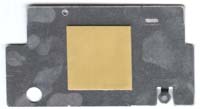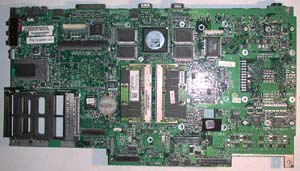Sager NP8886 2.8GHz Pentium 4
by Matthew Witheiler on January 21, 2003 4:56 AM EST- Posted in
- Laptops
Construction - Under the Hood (continued)
The top of the NP8886's motherboard holds additional goodies that give the system as much power as it has. Most prominently featured on the top of the motherboard is the Mobility Radeon 9000 graphics solution. The Mobility Radeon 9000 core is surrounded by four pieces of Samsung memory. The graphics chip and memory is mounted directly onto the motherboard and while in the system is covered via a thermal plate to facilitate cooling. This metal plate distributes the heat generated from the graphics chip up to a large metal sheet that lies under the keyboard.
 The video heat spreader. |
Like the Hypersonic system, the NP8886 turns to Texas Instruments to provide the IEEE-1394a, aka firewire, controller (likely because both systems are ODMed by the same company). The chip is a Texas Instruments TSB43AB21 controller which powers the single 6-pin unpowered firewire connection present on the notebook.

Also like the Hypersonic notebook, the NP8886 uses a VIA USB 2.0 controller as opposed to using the controller integrated in the ICH4 southbridge. The VIA VT6202 is likely used in place of the integrated controller because the previous 845DDR design of the notebook used the external USB controller and Clevo has not altered the design yet.

The AC'97 audio codec used by the NP8886 is the Realtek ACL201A chip.

The memory slots are located in the middle of the system and are user accessible by removing the keyboard and a few screws. Our unit came with 1.0GB of memory in two 512MB sticks.
There is a free mini-PCI slot on the motherboard ready to take any number of mini-PCI solutions. The system is not pre-wired with a wireless antenna, meaning adding an 802.11b wireless mini-PCI card to the system could prove to be a difficult task.
As we mentioned before, our sample Sager NP8886 came with not one but two 5400RPM mobile hard drives. Each bay was equipped with a Toshiba MK4019GAX 40.0GB for a total of 80.0GB of storage space. We were pleased to see that the system came with drives of the 5400RPM variety, as they do a good deal to lessen the I/O bottleneck that plagues notebook computers. Each drive was installed in a caddy system of sorts that made for fairly easy installation and removal.
Although we could not get the speakers out of the NP8886 out for a picture (they are glued in), the sound was comparable to other notebooks we have seen; they were fine for Windows sounds but left a lot to be desired when playing music or games. Speakers are one aspect of notebook computers that we wouldn't mind receiving some more attention from manufacturers. it seems that there must be something out there capable of producing better sound in an enclosure with limited space.















0 Comments
View All Comments